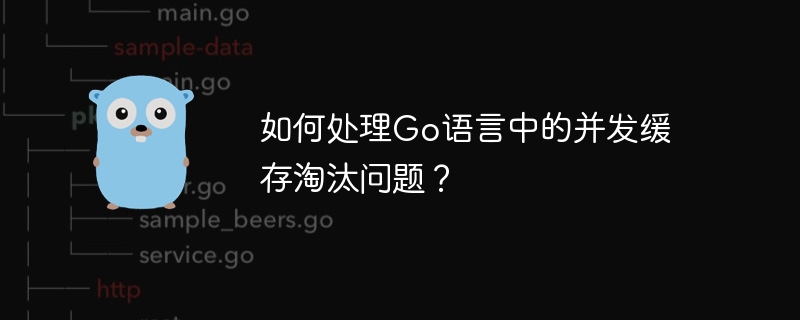

How to deal with the concurrent cache elimination problem in Go language?
Introduction
The concurrent cache elimination problem is a common challenge in the development process. In the Go language, due to its inherent support for concurrency, we can adopt some strategies to deal with concurrent cache eviction issues. This article will introduce several commonly used strategies and provide specific code examples.
1. LRU cache elimination strategy
LRU (Least Recently Used) is a common cache elimination strategy. When the cache is full, new data will replace the least recently used data.
In the Go language, you can use the container/list package to implement the LRU cache elimination strategy. First, we define a structure containing the cache size and a queue.
type LRUCache struct {
size int
cache map[string]*list.Element
list *list.List
}Next, we implement a Get method to obtain the data in the cache and update the usage order.
func (c *LRUCache) Get(key string) interface{} {
if element, ok := c.cache[key]; ok {
c.list.MoveToFront(element)
return element.Value
}
return nil
}Then, we implement a Put method to insert data into the cache, and eliminate the data that has not been used for the longest time when the cache is full.
func (c *LRUCache) Put(key string, value interface{}) {
if element, ok := c.cache[key]; ok {
c.list.MoveToFront(element)
element.Value = value
} else {
if c.list.Len() == c.size {
// 缓存已满,删除最久未使用的数据
evictedElement := c.list.Back()
delete(c.cache, evictedElement.Value.(string))
c.list.Remove(evictedElement)
}
// 新增数据到缓存
element := c.list.PushFront(value)
c.cache[key] = element
}
}2. LFU cache elimination strategy
LFU (Least Frequently Used, least frequently used) is another common cache elimination strategy. When the cache is full, the least used data will be replaced.
In the Go language, a hash table and a doubly linked list can be used to implement the LFU cache elimination strategy. First, we define a structure containing the cache size, hash table, and doubly linked list.
type LFUCache struct {
size int
cache map[string]*lfuNode
frequencyDLL *dll
minFrequency int // 记录当前缓存中最小的使用次数
}Next, we define a node structure to store cache data and the corresponding number of uses.
type lfuNode struct {
key string
value interface{}
frequency int
prev, next *lfuNode
}Then, we define a doubly linked list structure to store nodes and provide corresponding operation methods.
type dll struct {
head, tail *lfuNode
}
func (d *dll) insertAfter(node, newNode *lfuNode) {
newNode.prev = node
newNode.next = node.next
node.next.prev = newNode
node.next = newNode
}
func (d *dll) remove(node *lfuNode) {
node.prev.next = node.next
node.next.prev = node.prev
node.prev = nil
node.next = nil
}Finally, we implement a Get method and a Put method to obtain cached data and insert new data.
func (c *LFUCache) Get(key string) interface{} {
if node, ok := c.cache[key]; ok {
c.updateNode(node)
return node.value
}
return nil
}
func (c *LFUCache) Put(key string, value interface{}) {
if c.size == 0 {
return
}
if node, ok := c.cache[key]; ok {
node.value = value
c.updateNode(node)
} else {
if len(c.cache) >= c.size {
c.removeNode(c.frequencyDLL.head.next)
}
newNode := &lfuNode{key: key, value: value, frequency: 1}
c.addNode(newNode)
c.cache[key] = newNode
}
}
func (c *LFUCache) updateNode(node *lfuNode) {
c.removeNode(node)
node.frequency++
c.addNode(node)
}
func (c *LFUCache) removeNode(node *lfuNode) {
dll := c.frequencyDLL.getDLL(node.frequency)
dll.remove(node)
if c.minFrequency == node.frequency && dll.head.next == nil {
c.minFrequency++
}
delete(c.cache, node.key)
}
func (c *LFUCache) addNode(node *lfuNode) {
dll := c.frequencyDLL.getDLL(node.frequency)
dll.insertAfter(dll.head, node)
if dll != c.frequencyDLL.head.next && dll.head.next == node {
c.frequencyDLL.getDLL(node.frequency - 1).remove(node)
}
if c.minFrequency == 0 {
c.minFrequency = node.frequency
}
c.cache[node.key] = node
}Conclusion
The above are two common strategies for dealing with concurrent cache elimination problems in the Go language: LRU and LFU. By using appropriate data structures and algorithms, we can solve the concurrent cache eviction problem efficiently. Hopefully the code examples in this article will help readers better understand and apply these strategies.
The above is the detailed content of How to deal with concurrent cache eviction problem in Go language?. For more information, please follow other related articles on the PHP Chinese website!
 Usage of Type keyword in Go
Usage of Type keyword in Go
 How to implement linked list in go
How to implement linked list in go
 What are the Go language programming software?
What are the Go language programming software?
 How to learn go language from 0 basics
How to learn go language from 0 basics
 What are the methods to implement operator overloading in Go language?
What are the methods to implement operator overloading in Go language?
 What are the operators in Go language?
What are the operators in Go language?
 504 Gateway Time-out
504 Gateway Time-out
 How to export word from powerdesigner
How to export word from powerdesigner




